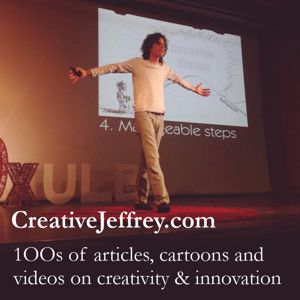Report 103
Your newsletter on applied creativity, imagination, ideas and innovation in business.
Tuesday, 1 April 2008
Issue 125
Hello and welcome to another issue of Report 103, your fortnightly newsletter on creativity, imagination, ideas and innovation in business.
As always, if you have news about creativity, imagination, ideas, or innovation please feel free to forward it to me for potential inclusion in Report103. Your comments and feedback are also always welcome.
Information on unsubscribing, archives, reprinting articles, etc can be found at the end of this newsletter.
INNOVATION MAY BE DETRIMENTAL TO BUSINESS
A report released today by the Grap Instituut voor Handels Onderzoek (GIHO) at Leuven University – and in which I was invited to participate – has come to an alarming conclusion. Based on in-depth surveys at 104 companies in Belgium, the Netherlands and Ireland, it was found that more often than not innovation is actually detrimental to most businesses. Unlike other research in business innovation, the GIHO team made no assumptions about the value of innovation (most innovation research makes the assumption innovation is a good thing). In addition, we talked not only to the business managers, but also to employees, customers and business partners. What we discovered will surprise you.
Among the many findings of GIHO's research, several key points came up again and again.
1. Customers Often Do Not Like Innovation
Customers are becoming increasingly frustrated by crowded shop shelves full of products with confusing new features. Common complaints focused on confusion, not believing new features offered any real improvement and frustration at not being able to find a tried and preferred product. One shopper summed it up very well. “I don't understand why [company name] constantly changes their shampoos. Twenty years ago, I went into the supermarket and bought a bottle of [brand x] shampoo. It cleaned my hair just fine. Now, I go into the supermarket and have to choose between a dozen different kinds of shampoos – all of which have 'new' scrawled across the bottle. But I don't think any of them wash my hair better than did the simple shampoo I used to buy!”
In addition, an excess of new products requires consumers spend more time finding the products they want. Moreover, considerable time is needed for reading product labels in detail to find what they are looking for. Based on consumer estimates, a typical trip to the supermarket takes 20 minutes longer today than it did a decade ago.
2. Employees Are Uncomfortable with Innovation Initiatives
Customers are not the only ones getting fed up with innovation. As employees are being drawn into corporate innovation initiatives, many feel they are being laden with additional tasks irrelevant too their job profiles. “I studied accountancy at University, I've been an accountant – and a good one – for six years and I joined this company to head the accounting department,” says one frustrated Accounting Manager, “If I had wanted to be creative, I would have gone into advertising or design. As it is, I hate being prodded to be creative all the time.”
In particular, many employees note that although they are being asked to be more creative and innovative, and to spend time developing creative ideas – their existing workload is not being reduced in order to provide additional time to be creative. “If management really wanted our division to be more creative, they would supply us with additional people so we would all have time to be more creative,” remarked one division manager in a large services firm.
Likewise, many employees find the concept of innovation to be too vague. For those who prefer precise tasks with concrete goals, being told to submit innovative ideas is confusing. “I am not creative. I don't understand what they want!” was a typical remark heard by researchers.
3. Cost Savings are Largely Illusory
One of the major reasons cited for organisational innovation is cutting operational costs. However, GIHO found that when examining the big picture, many of those savings did not exist or were so small as to be irrelevant.
When you include the cost of implementing the changes, training employees how to use the new procedures, losses due to mistakes in the early stages of implementation and reluctance of employees to change their ways, you often find that the cost savings to be achieved through the change may take years to be realised. And in this environment of constant change, the chances are the operation changes you implement today will be obsolete in two to three years' time. In other words, the cost of implementing an efficient process improvement is less than the savings that will be realised over the life of the improvement.
Imagine a production line that produces 50,000 product units per year, worth $100 each. An employee has an idea to improve the production efficiency and save $5 per unit. That would equal a savings of $250,000 per year. At first glance, that sounds good. But, assume that the cost of the new equipment required to perform the efficiency is $500,000. In addition, training production staff and putting the production line out of operation for two weeks in order to install the new equipment and train employees costs another $250,000. The result: it would take three years to realise the savings offered by the idea. But three years from now, the company may not even be making that product any more.
“Off-shoring to China and reducing our workforce would save a lot more,” remarked one cynical senior manager. Although he was eager to point out that this was not his company's intention.
Also noted in the research is that employees do not like change, particularly those on the factory floor. “We may come up with a simple process that saves a Euro for every product we make,” points out one production manager. “But the guys won't like making that change. So, they work more slowly and make more mistakes. In the end, it costs us an additional two euro for every product.” so much for cost savings.
4. Income on Product Innovation Trivial
Of course the Holy Grail of innovation has always been the radical new product that captures the market and leaves the competition in the dust. In fact, the value of significant product innovation is much smaller than assumed – and is sometimes negative!
To understand why, one simply has to look at Hollywood, which has been attempting to produce creative films for years. Every year the studios produce numerous films. Many just break even. Many lose money. But the Studios hope and expect one or two films to be hits – and generate sufficient income to cover the losses that from the money losers. If you look at most film studios' books, you'll see that their businesses are no more profitable than any other – but a lot riskier.
Business product innovation is based largely on the same model. A company has to develop and deliver numerous innovative new products, most of which will fail in the marketplace, in order to find that innovative wonder that everyone likes.
“No amount of market research, testing or expert evaluation can indicate which products will be winners,” says the CEO of a Dutch technology company known for innovation. “some products are clearly far superior to anything on the market. But for whatever reason, no one wants to buy them.”
Research shows that for highly innovative companies, about one in eight innovative new products will succeed in the marketplace. If it costs $1 million for each product launch, the successful product needs to earn $9 or $10 million to cover loses from the failures as well as interest payments and lost opportunities. For medium sized businesses that is not usually a viable business model.
Summary: the Biggest Surprise
When asked to summarise their shocking findings at a press conference in Brussels this morning, the lead researchers at GIHO jumped out of their chairs and shouted: “April Fools!!!”
Sorry, folks. The above article was completely made up. Not even GIHO exists. But the rest of this issue of Report 103 is entirely serious! Enjoy.
IDEA MANAGEMENT PRIMER
Idea management is a topic often covered in this journal. It is also our main business: Jenni Idea Management Software Service (http://www.creativejeffrey.com/jenni/index.php). Yet in the 125 issues of Report 103, we have never actually written an article describing idea management. It's time to change that.
In any medium to large business, government office or other organisation, employees have ideas, lots of ideas. If you are in any doubt, just visit the staff canteen during any lunch hour and keep your ears open. You will hear people complaining about inefficient operational processes, wishing company products had this feature or that feature and wondering why management doesn't offer an obvious business service which clients keep asking about. Each of these complaints and wishes are wrapped around an idea for improving operations, products and services.
And while management often have strategic ideas, it is the employees who are on the factory floors, running day to day operations, meeting with customers and serving customers who have the lion's share of ideas that at minimum improve efficiency and thereby cut operational costs and at best may transform your business (Post-its, for instance, were devised and developed by 3M employees – not management).
Yet, most businesses leave the innovating to management – and ignore the many potentially lucrative ideas locked up in their employees' minds. As a result, many innovative ideas are missed out upon. And with most managers proclaiming that innovation is critical to their firms, not exploiting this opportunity is a tremendous mistake.
Idea Management to the Rescue
Fortunately, there is a solution: idea management. Idea Management is a structured
process for capturing ideas from across the work force and evaluating those
ideas in order to determine which have the greatest potential.
In smaller to medium sized firms, the first foray into Idea Management is often
a dedicated e-mail address where employees may submit ideas. A team typically
reviews all ideas on a regular basis and decides which ideas to develop. At
the other end of the spectrum, more and more companies are implementing sophisticated
idea management software products with a range of features designed to support
the innovation process.
Two Models of Idea Management
Idea management software tools use one of two models for capturing and processing ideas:
- Suggestion schemes
- Ideas campaigns
Unfortunately, one of these models is almost inevitably doomed for failure within 12-18 months of inception. The other is more effective for a sustainable innovation programme.
Suggestion Schemes
Many companies launch their first forays into idea management with suggestion scheme software, either designed in house or purchased from a specialist vendor.
The suggestion scheme is, of course, based on the suggestion box. The underlying concept is that whenever someone has an idea, she can drop it in the suggestion box which, in the case of software, is typically a form on a web interface.
The software will include tools for developing, processing and evaluating the submitted ideas.
It is a good theory, but does not last long in practice. Having talked with numerous managers who have launched suggestion schemes, I've found that they inevitably fail after 12-18 months – usually because they have filled up with ideas faster than the team in charge can manage those ideas.
As a result, idea submitters note that nothing is happening to their ideas and become discouraged. The managing team cannot cope with the workload and become frustrated. Moreover, a very high percentage of ideas must be rejected for not being relevant to business needs. This is also demotivating. The result: the system stagnates.
Ideas Campaigns
The concept of an ideas campaign is based on creative problem solving (CPS) methodology – a tried and tested approach to creative idea generation. Rather than having an open suggestion scheme begging for any kind of idea, an ideas campaign is a focused approach with five steps:
-
An ideas campaign begins with an innovation challenge based on a business problem or issue.
-
Promotion: employees are encouraged to participate and solve the challenge.
-
Participants develop ideas in a collaborative environment over a set period of time.
-
The most promising ideas are selected and sent to teams of experts for evaluation.
-
The winning ideas are implemented.
The challenge is the key to an effective ideas campaign. A well designed challenge pushes people to think up and develop ideas that solve the relevant business problem. A poorly designed challenge may generate great ideas – but they may not be the ideas you need to solve your problem.
Because an ideas campaign is a closed, time limited event, it offers several advantages over ideas campaigns.
-
An ideas campaign generates relevant business ideas you can use immediately.
-
An innovation challenge motivates people to think creatively (imagine going to a brainstorming event where the facilitator demanded ideas, but did not provide a challenge or any guidance as to what kind of ideas she wanted. This is what a suggestion scheme is like).
-
You generate multiple solutions to a specific business problem. Often several of those solutions can be implemented together in order to provide a higher level of innovation.
-
Because ideas campaigns are focused on specific business issues, division managers with the relevant expertise can manage those ideas campaigns. They are best placed to be able to interpret the ideas that come in and oversee their evaluation. This frees up innovation managers to focus on the overall innovation strategy.
-
At the end of an ideas campaign, it is closed and all information archived for future reference. Hence you do not end up with a repository full of un-reviewed ideas as often happens in suggestion schemes.
A long term, sustainable idea management programme by ideas campaign involves running frequent – often overlapping – ideas campaigns overseen by different managers. This results in a steady flow of innovative ideas in all divisions of your organisation.
Clearly, idea management by ideas campaign is the better approach to idea management. Nevertheless, for small firms or individual units within a larger firm, a suggestion scheme by e-mail – particularly one in which colleagues are sent challenges on a regular basis – may prove a useful interim approach to idea management. But don't expect it to last much longer than a year!
To read a more detailed introduction to idea management, you are welcome to download my Introduction to Idea Management booklet (16 pages: 473KB) at http://www.creativejeffrey.com/creative/ideamanagement.php.
To learn more about Jenni, our idea management software service (which combines software delivered over the web with our full support and innovation coaching), please visit http://www.creativejeffrey.com/jenni/ .
REPLACE CHALLENGES WITH CALLS TO ACTION
In this newsletter and in our advice to clients using Jenni idea management software service, we recommend innovation challenges start with phrases like: “In what ways might we...?” or “How might we..?”. We are not alone. Creativity and innovation specialists who use creative problem solving and ideas campaigns also widely use such phrases.
However, we may have been a little too effective in our training and coaching. Looking at innovation challenges behind ideas campaigns in some of our clients' implementations of Jenni, we have seen that sometimes innovation challenges should be replaced with explicit calls for action.
Let's look at some examples based on those I've seen (but note, I've changed the challenges somewhat to respect the privacy of our clients' ideas campaigns.
Challenge 1: “In what ways might we develop a more effective slogan for product X?”
Comment: This is a rather obtuse approach to developing a new slogan. Since users of the idea management tool can readily enter text, a better approach would be a direct call to action, such as “Propose a new slogan for product X!” or “Propose a creative new slogan for product X!”
Yet even that is probably jumping the gun. It would make more sense to start by asking a direct question: “What aspects of product X should we emphasise in the new slogan?” once this has generated some ideas and you have evaluated those ideas to identify the best aspects to promote, then you can challenge people to propose a new slogan. And you can provide a list of key aspects as background information associated with the challenge.
Challenge 2: “How might we design a can – that emphasises the healthy benefits of our new beverage?”
Comment: in this case, the client had already identified through research and the demands of the marketing department what the can should emphasise. So, a more proactive approach would have been to invite participants to “Design a can that emphasises the healthy benefits of our new beverage”. Employees could have sketched ideas, scanned them and uploaded them. Designers could have made roughs in their software tools and uploaded them. After all, Jenni allows users to upload images with their ideas.
Even in an organisation without Jenni, ideas could have been posted onto an intranet or even stuck to a wall for people to look at and comment on.
Of course such challenges are relatively rare. That's why the experts tend to recommend a particular phraseology for innovation challenges. Nevertheless, then you your end product is words, an image or a video clip, it may sometimes be more effective to make your challenge a call for action.
Note: If you would like more information on framing innovation challenges, I recommend Getting to Innovation by Dr. Arthur B. VanGundy and published by Amacom.
CREATIVE SOLUTIONS FOR CONSUMER NEEDS
Innovation based on consumer needs as the key to successful innovation. This
notion prompted Saskia Relker, 36, to develop the concept behind
www.iwishtherewas.com, a website where consumers can post all their practical
problems and where companies can learn about consumer wishes.
Saskia Relker explains, “I came across questions such as ‘Why can't
you buy freshly made baby food?' or 'Why is there no universal phone charger?'.
Apparently there is a need for a place where consumers can share their practical
desires and problems, with the intention to have something actually done about
them. I’ve noticed that lots of people are bursting with great ideas,
which are often based on practical everyday problems.”
Hole in the Market
No other company or market research firm comes even close to the source where
these questions originate. www.iwishtherewas.com fills this hole. According
to Relker, who advises companies regarding concept development, the platform
offers the unique opportunity to stimulate open innovation. Moreover, ideas
from the market can be brought to the attention of developers in an easy and
accessible way.
Enthusiasm in the Business Community
There is a good chance that something will be done with all those wishes, judging by the enthusiastic response of the business community. Even before the site was launched, Simbon-B04, the largest specialist in Open Innovation in the Netherlands, signed up. The company sees potential in this initiative and supports it. “Innovation based on actual needs is the key to successful innovation. We believe strongly in this concept,” says Director Jac Goorden. To ensure a varied, yet high-quality stream of ideas, the website, which has been developed in English, is accessible to a large international audience.
LATEST IN BUSINESS INNOVATION
If you want to keep up with the latest news in business innovation, I recommend Chuck Frey's INNOVATIONweek (http://www.innovationtools.com/News/subscribe.asp). It's the only e-newsletter that keeps you up-to-date on all of the latest innovation news, research, trends, case histories of leading companies and more. And it's the perfect complement to Report 103!
Happy thinking!
Jeffrey Baumgartner
---------------------------------------------------
Report 103 is a complimentary weekly electronic newsletter from Bwiti bvba of Belgium (a jpb.com company: http://www.creativejeffrey.com). Archives and subscription information can be found at http://www.creativejeffrey.com/report103/
Report 103 is edited by Jeffrey Baumgartner and is published on the first and third Tuesday of every month.
You may forward this copy of Report 103 to anyone, provided you forward it in its entirety and do not edit it in any way. If you wish to reprint only a part of Report 103, please contact Jeffrey Baumgartner.
Contributions and press releases are welcome. Please contact Jeffrey in the first instance.




